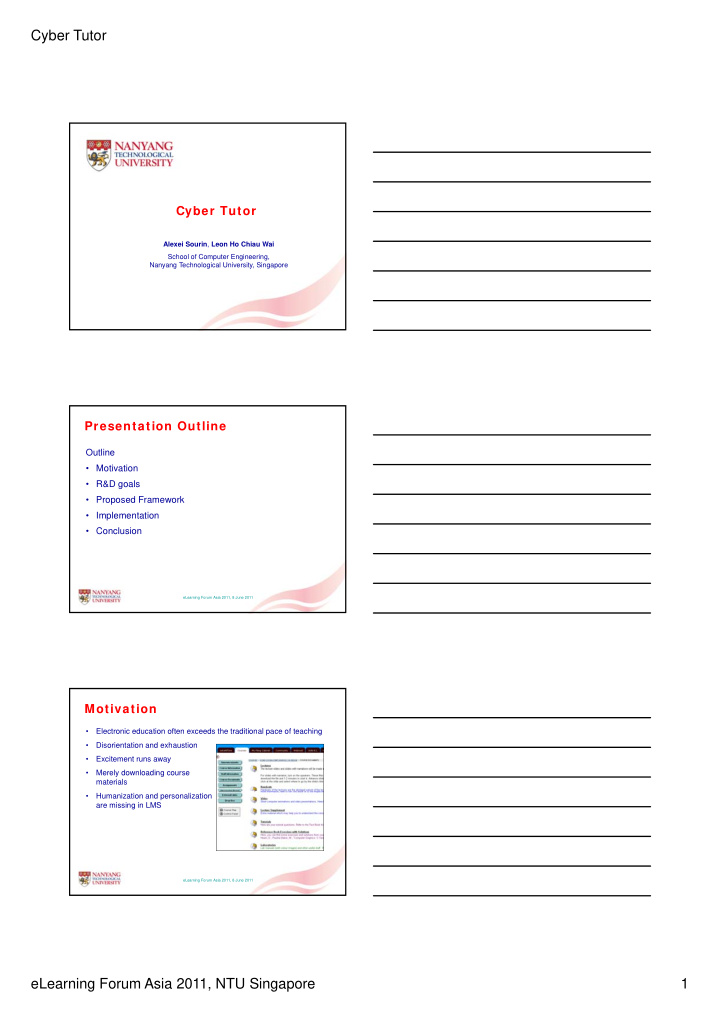



Cyber Tutor Cyber Tutor Alexei Sourin , Leon Ho Chiau Wai School of Computer Engineering, Nanyang Technological University, Singapore eLearning Forum Asia 2011, 8 June 2011 Presentation Outline Outline • Motivation • R&D goals • Proposed Framework • Implementation • Conclusion eLearning Forum Asia 2011, 8 June 2011 Motivation • Electronic education often exceeds the traditional pace of teaching • Disorientation and exhaustion • Excitement runs away • Merely downloading course materials • Humanization and personalization are missing in LMS eLearning Forum Asia 2011, 8 June 2011 eLearning Forum Asia 2011, NTU Singapore 1
Cyber Tutor Hypothesis • Adding to LMS various AI talking agents with tunable look and feel as well as different ways of delivering educational content may engage students better and give them a feeling of real personalized teaching rather than detached “computer” education • Should be used optionally • Should not replace other ways of e-learning • May integrate other e-learning tools in addition how it can be done by LMS eLearning Forum Asia 2011, 8 June 2011 R&D goals • To design and develop a generic AI cyber tutor with the abilities: – To maintain conversation and answer specific course-related questions – To deliver content using various media forms – To allow for tunable • Visual appearance • Voice • Environment/background and accessories • Multiple delivery ways ranging from 3D shared virtual spaces to IM devices and mobile devices • Low implementation and maintenance cost preferably based on open source and multi-platform software eLearning Forum Asia 2011, 8 June 2011 Cyber tutor com ponents • Cyber tutor components: – AI – GUI (may have several) – Delivery platform (may have several) • Selected software components Selected software components – AI: AIML (Artificial Intelligence Markup Language) and A.L.I.C.E. brain (http://alicebot.org) as a core part – GUI: 3D Haptek talking head (http://www.haptek.com), VRML avatar, text chat – Delivery platform: web-based, 3D VRML, chat in IM services, standalone eLearning Forum Asia 2011, 8 June 2011 eLearning Forum Asia 2011, NTU Singapore 2
Cyber Tutor AI brain • ALICE (Artificial Linguistic Internet Computer Entity) is a natural language processing chatterbot—a program that engages in a conversation with a human by applying some heuristical pattern matching rules to the human's input • Inspired by Joseph Weizenbaum's classical ELIZA program • Additional knowledge files/categories can be added to the core database database • It can be also augmented with other knowledge databases The log spiral plots all 24,000 categories in the ALICE Brain. The spiral itself represents the root. The trees emerging from the root are the patterns recognized by ALICE. The branching factor for the root is about 2000, but the average branching factor of the second pattern word is only about two. (http://www.alicebot.org/documentation/gallery/) eLearning Forum Asia 2011, 8 June 2011 GUI : Haptek, VRML, text chat • Haptek software creates photo-realistic, 3-D, full-bodied, fully animated, morphing and emotive characters in dynamic environments that visually and verbally interact with the user and with one another over the Internet • VRML Humanoid Animation (H-Anim) is an approved ISO standard for humanoid modeling and animation H-Anim defines a for humanoid modeling and animation. H Anim defines a specification for defining interchangeable human figures so that those characters can be used across a variety of 3D games and simulation environments • Text chat can be implemented by java scripts as well as delivered through various IM services eLearning Forum Asia 2011, 8 June 2011 Proposed Fram ew ork • Cyber-instructor Server-Client Architecture eLearning Forum Asia 2011, 8 June 2011 eLearning Forum Asia 2011, NTU Singapore 3
Cyber Tutor Proposed Fram ew ork • Server-side implementation • Client-side implementation eLearning Forum Asia 2011, 8 June 2011 Proposed Fram ew ork • Integration of Cyber-instructor and IMified eLearning Forum Asia 2011, 8 June 2011 I m plem entation • Capabilities of Cyber tutor developed – Maintaining common conversation – Answering technical questions on the topic of the subjects taught providing answers in text and multimedia form – Changing its look and feel following the user configurations – Memorizing information provided by the users to enrich, replace g p y , p or augment its knowledge database – Showing visual emotions followed the content of the conversation – Can be accessed from the web pages as well as from various IM services such as MSN, GoogleTalk, Yahoo Messenger etc. eLearning Forum Asia 2011, 8 June 2011 eLearning Forum Asia 2011, NTU Singapore 4
Cyber Tutor I m plem entation • Cyber-instructor home page eLearning Forum Asia 2011, 8 June 2011 I m plem entation • Text & Multimedia conversation eLearning Forum Asia 2011, 8 June 2011 I m plem entation • Conversation with the same cyber tutor but in 3D shared virtual world – virtual Campus of NTU eLearning Forum Asia 2011, 8 June 2011 eLearning Forum Asia 2011, NTU Singapore 5
Cyber Tutor I m plem entation • Conversation via Google talk eLearning Forum Asia 2011, 8 June 2011 Conclusion • Developed cyber tutor with expandable AI brain, various GUIs, tuneable look and feel, and emotions • Cyber tutors may finally engage many students in real education and significantly enhance their cyber-learning experience with personal mentoring as well as enable p p g many teachers to create and tune their own Cyber tutors so as to provide fun and effective teaching for their students eLearning Forum Asia 2011, 8 June 2011 Thank you Q&A eLearning Forum Asia 2011, 8 June 2011 eLearning Forum Asia 2011, NTU Singapore 6
Recommend
More recommend